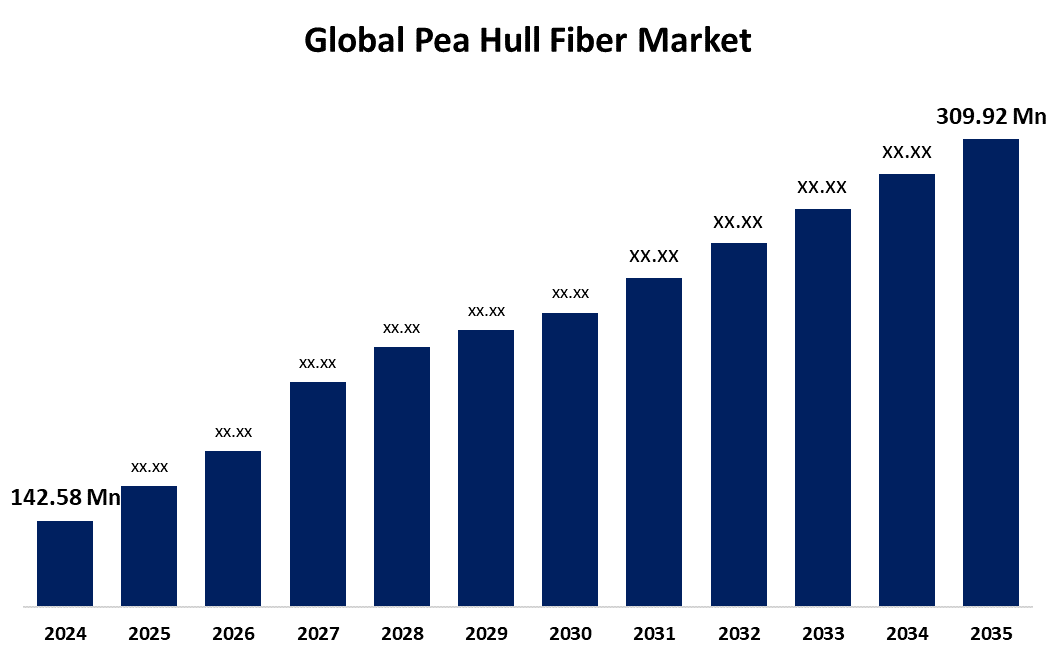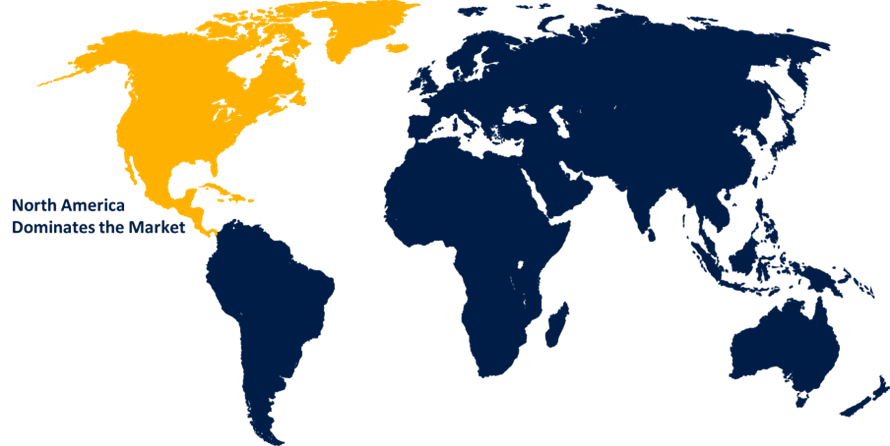Global Pea Hull Fiber Market Size, Share, and COVID-19 Impact Analysis, By Type (Organic Pea Hull Fiber and Conventional Pea Hull Fiber), By Application (Textile Industry, Paper and Pulp Industry, Composite Materials, Food Industry and Pharmaceuticals), and By Region (North America, Europe, Asia-Pacific, Latin America, Middle East, and Africa), Analysis and Forecast 2025 - 2035
Industry: Food & BeveragesGlobal Pea Hull Fiber Market Insights Forecasts to 2035
- The Global Pea Hull Fiber Market Size Was Estimated at USD 142.58 Million in 2024
- The Market Size is Expected to Grow at a CAGR of around 7.31% from 2025 to 2035
- The Worldwide Pea Hull Fiber Market Size is Expected to Reach USD 309.92 Million by 2035
- Asia Pacific is Expected to Grow the fastest during the forecast period.

Get more details on this report -
The Global Pea Hull Fiber Market Size was worth around USD 142.58 Million in 2024 and is predicted to Grow to around USD 309.92 Million by 2035 with a CAGR of 7.31% from 2025 and 2035. Increasing health consciousness and demand for dietary fiber, expansion of plant-based and clean-label foods, functional properties in texture and shelf life, along with increasing uses in pharmaceuticals and animal feed are major drivers of the pea hull fiber market.
Market Overview
The pea hull fiber market is the industry segment dedicated to the manufacture, processing, and marketing of fiber derived from the outer covers (shells or hulls) of peas. The natural, plant-based fiber is greatly prized for its nutritional value, particularly its high fiber diet content and functional attributes like enhancing texture and moisture retention in foodstuffs. The market caters to various industries such as food and beverages, pharmaceuticals, animal feed, paper, textiles, and composites. Pea hull fiber is rich in various benefits such as enhancing digestive health, assisting weight management, and maintaining the balance of blood sugar levels. The product is gluten-free, non-GMO, and hypoallergenic and can be used according to various dietary requirements. Further, its functional performance aids in enhancing the texture, shelf life, and water-holding capacity of processed foods without compromising flavor, which makes it attractive to both manufacturers and consumers. Further, market innovations center on enhancing extraction process efficiencies to improve fiber purity and functionality, creating new food formulations, and venturing into new applications like biodegradable packaging and sustainable composites. These developments support changing consumer needs and further establish pea hull fiber as a clean, sustainable ingredient across various sectors.
Report Coverage
This research report categorizes the pea hull fiber market based on various segments and regions, forecasts revenue growth, and analyzes trends in each submarket. The report analyses the key growth drivers, opportunities, and challenges influencing the pea hull fiber market. Recent market developments and competitive strategies such as expansion, type launch, development, partnership, merger, and acquisition have been included to draw the competitive landscape in the market. The report strategically identifies and profiles the key market players and analyses their core competencies in each sub-segment of the pea hull fiber market.
Pea Hull Fiber Market Report Coverage
| Report Coverage | Details |
|---|---|
| Base Year: | 2024 |
| Market Size in 2024: | USD 142.58 Million |
| Forecast Period: | 2025-2035 |
| Forecast Period CAGR 2025-2035 : | 7.31% |
| 2035 Value Projection: | USD 309.92 Million |
| Historical Data for: | 2020-2023 |
| No. of Pages: | 228 |
| Tables, Charts & Figures: | 110 |
| Segments covered: | By Type, By Application, and COVID-19 Impact Analysis |
| Companies covered:: | ExxonMobil, Lanxess, PJSC NizhneKamskneftekhim, Sibur, JSR, Sinopec Beijing Yanshan, Formosa Synthetic Rubber (Ningbo), Zhejiang Cenway Synthetic New Material, Panjin Heyun Group, Shandong Chambroad Petrochemicals, and Others. |
| Pitfalls & Challenges: | Covid-19 Empact, Challenges, Growth, Analysis. |
Get more details on this report -
Driving Factors
Consumers globally are increasingly health-oriented, with diets prioritizing digestive wellness, lowering cholesterol, and facilitating weight management. Dietary fiber has an important role to play in these benefits. Pea hull fiber, being a natural source of plant fiber, strongly resonates with this demand, prompting manufacturers to use it in a variety of foodstuffs, which enhances market growth. Additionally, pea hull fiber provides several functional benefits like texture improvement, moisture maintenance, and shelf-life enhancement in foods such as baked goods, snacks, and meat substitutes. Its neutral flavor and small particle size make it convenient for inclusion without influencing taste, which makes it of significant interest to product developers seeking to add nutrition without compromising product quality.
Restraining Factors
Pea hull fiber is competing with traditional fibers like cellulose, wheat bran, oat fiber, and inulin. Consumers and manufacturers consider these alternatives because they have been used longer, their functionality is proven, or they are cheaper. This competition hinders the growth of the pea hull fiber market. Additionally, most consumers are yet to be aware of pea hull fiber and its benefits over other fibers like wheat or oat. This unawareness constrains demand, particularly in areas where educational levels of dietary fiber variety are low. Without wide consumer knowledge, market expansion may be slower since producers hold back too heavily.
Market Segmentation
The pea hull fiber market share is classified into type and application.
- The conventional pea hull fiber segment dominated the market in 2024 and is projected to grow at a substantial CAGR during the forecast period.
Based on the type, the pea hull fiber market is divided into organic pea hull fiber and conventional pea hull fiber. Among these, the conventional pea hull fiber segment dominated the market in 2024 and is projected to grow at a substantial CAGR during the forecast period. The segmental growth is due to traditional pea hull fiber being economical to produce compared to organic types, hence being viable for mass food processing and industrial uses. Its relative affordability is attractive to manufacturers concerned with prices and bulk production, especially in the high-volume markets of snacks, bakery products, and animal feed, thus providing a broader market base.
- The food industry segment accounted for the highest share in 2024 and is anticipated to grow at a significant CAGR during the forecast period.
Based on the application, the pea hull fiber market is divided into the textile industry, paper and pulp industry, composite materials, food industry, and pharmaceuticals. Among these, the food industry segment accounted for the highest share in 2024 and is anticipated to grow at a significant CAGR during the forecast period. The growth is attributed to consumers increasingly looking for foods with dietary fiber for digestive well-being, weight control, and general well-being. Pea hull fiber, being natural and efficient in providing fiber, is incorporated into numerous food applications. This increasing health awareness significantly influences the demand for food applications, making it the dominant application segment.
Regional Segment Analysis of the Pea Hull Fiber Market
- North America (U.S., Canada, Mexico)
- Europe (Germany, France, U.K., Italy, Spain, Rest of Europe)
- Asia-Pacific (China, Japan, India, Rest of APAC)
- South America (Brazil and the Rest of South America)
- The Middle East and Africa (UAE, South Africa, Rest of MEA)
North America is anticipated to hold the largest share of the pea hull fiber market over the predicted timeframe.

Get more details on this report -
North America is anticipated to hold the largest share of the pea hull fiber market over the predicted timeframe. North America boasts a very health-aware demographic who are more and more looking for fiber, plant-based, and clean-label products. Heightened awareness regarding gut health, obesity, and heart disease has resulted in greater uptake of functional foods and supplements. People prefer foods with ingredients providing nutritional as well as digestive benefits without the use of synthetic additives. Pea hull fiber, being natural, non-GMO, and allergen-free, is right on target with this trend. This trend generates constant and compelling demand, thereby positioning North America as a prime market for dietary fiber innovation.
Asia Pacific is expected to grow at a rapid CAGR in the pea hull fiber market during the forecast period. Asia-Pacific's nutraceutical and functional food market is growing strongly, fueled by preventive healthcare and traditional health philosophies (e.g., TCM, Ayurveda). Pea hull fiber is finding growing applications in fortified foods, beverages, and supplements that promote digestive health. Local players are introducing fiber-fortified products to address consumer demand for gut-friendly nutrition. Diversification into product formats such as from bars and cereals to capsules has spurred growth in the fiber market, making APAC one of the most dynamic regions for the growth of functional ingredients.
Europe is predicted to hold a significant share of the pea hull fiber market throughout the estimated period. European consumers are increasingly following plant-based and clean-label diets due to health, ethical, and environmental motives. Pea hull fiber, as a natural, non-GMO, and environmentally sustainable ingredient, perfectly aligns with this trend. The region's well-developed plant-based food market employs pea fiber in bakery, meat alternatives, and drinks, aiding market growth. Health-aware consumers are appreciative of its digestive health benefits, contributing to strong demand and resultant high market share for Europe within the segment.
Competitive Analysis:
The report offers the appropriate analysis of the key organizations/companies involved within the pea hull fiber market, along with a comparative evaluation primarily based on their type of offering, business overviews, geographic presence, enterprise strategies, segment market share, and SWOT analysis. The report also provides an elaborative analysis focusing on the current news and developments of the companies, which includes type development, innovations, joint ventures, partnerships, mergers & acquisitions, strategic alliances, and others. This allows for the evaluation of the overall competition within the market.
List of Key Companies
- ExxonMobil
- Lanxess
- PJSC NizhneKamskneftekhim
- Sibur
- JSR
- Sinopec Beijing Yanshan
- Formosa Synthetic Rubber (Ningbo)
- Zhejiang Cenway Synthetic New Material
- Panjin Heyun Group
- Shandong Chambroad Petrochemicals
- Others
Key Target Audience
- Market Players
- Investors
- End-users
- Government Authorities
- Consulting And Research Firm
- Venture capitalists
- Value-Added Resellers (VARs)
Recent Development
- In October 2022, Brightseed launched Brightseed Bio 01 (also known as Bio Gut Fiber), an upcycled dietary fiber ingredient derived from hemp hulls, identified through their AI platform, Forager.
Market Segment
This study forecasts revenue at the global, regional, and country levels from 2020 to 2035. Spherical Insights has segmented the pea hull fiber market based on the below-mentioned segments:
Global Pea Hull Fiber Market, By Type
- Organic Pea Hull Fiber
- Conventional Pea Hull Fiber
Global Pea Hull Fiber Market, By Application
- Textile Industry
- Paper and Pulp Industry
- Composite Materials
- Food Industry
- Pharmaceuticals
Global Pea Hull Fiber Market, By Regional Analysis
- North America
- US
- Canada
- Mexico
- Europe
- Germany
- UK
- France
- Italy
- Spain
- Russia
- Rest of Europe
- Asia Pacific
- China
- Japan
- India
- South Korea
- Australia
- Rest of Asia Pacific
- South America
- Brazil
- Argentina
- Rest of South America
- Middle East & Africa
- UAE
- Saudi Arabia
- Qatar
- South Africa
- Rest of the Middle East & Africa
Frequently Asked Questions (FAQ)
-
1. What is the CAGR of the pea hull fiber market over the forecast period?The global pea hull fiber market is projected to expand at a CAGR of 7.31% during the forecast period.
-
2. What is the market size of the pea hull fiber market?The global pea hull fiber market size is expected to grow from USD 142.58 Million in 2024 to USD 309.92 Million by 2035, at a CAGR of 7.31% during the forecast period 2025-2035.
-
3. Which region holds the largest share of the pea hull fiber market?North America is anticipated to hold the largest share of the pea hull fiber market over the predicted timeframe.
Need help to buy this report?